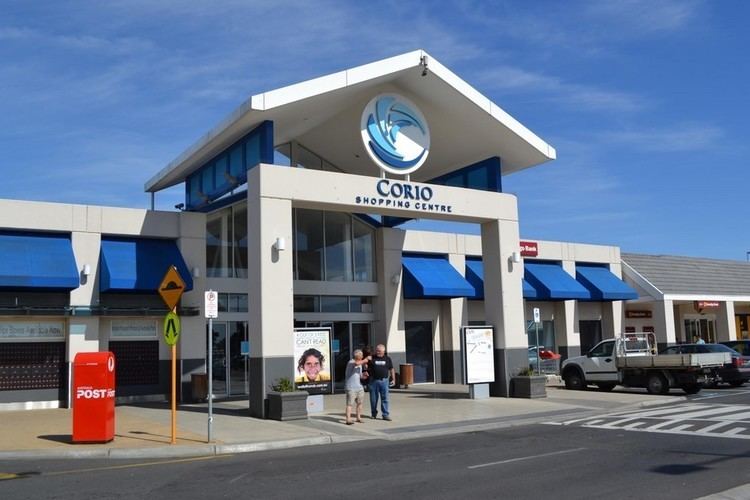Population 14,919 (2006 census) Postcode(s) 3214 Area 12.6 km² | Established 1860s Postal code 3214 | |
 | ||
LGA(s) City of Greater Geelong | ||
Corio is a residential and industrial area, which forms one of the largest suburbs of Geelong, Victoria in Australia. It is located approximately 9 km north of the Geelong central business district. The area was formerly known as Cowie's Creek after James Cowie, an early land owner who was active in the local and state government.
Contents
Map of Corio VIC 3214, Australia
History
Explorers Hume and Hovell reached Corio and reported that the local Aborigines referred to the area as 'coraiyo', loosely meaning 'small marsupial' or 'sandy cliffs'.
The land was first subdivided and sold in 1852 as "Cowie's Creek". By the 1860s, Cowie's Creek was home to two hotels and a population of approximately 500 people.
A post office opened on November 16, 1864, and was renamed as Corio Post Office in 1913. It was situated on School Road, adjacent to a railway level crossing. In 1963, it was again renamed Corio "North" Post Office when the contemporary Corio Post Office inside of the Corio Shopping Centre was opened. This is now located on the ground floor, having moved from its original first floor location. Corio North Post Office was closed in 1977.
In 1914, the Geelong Grammar School moved to its current location near Limeburners Lagoon, an arm of Corio Bay.
The Corio Village Shopping Centre was opened in 1973. The Shopping Centre currently includes a K-Mart, Coles, Woolworths, Best & Less, McDonald's, Subway, Gloria Jean's Coffees, Optus, Telstra, Dodo Connect outlets, Cotton On, Millers, a Tattslotto agency, major banks, and a number of Australian Government agencies which include the Australia Post and a Centrelink office. After a re-development in 2007/08, it became known as the Corio Shopping Centre.
The Aldi supermarket chain built a store adjacent to Beckley Park in the mid-2000s. Harvey Norman and Muzz Buzz are located on the Princes Highway entering Geelong from Melbourne. Nearby is a new retail development for several large stores with a Red Rooster at its entrance.
Industry
The most notable industry in Corio is the Shell refinery, which opened in 1956. In February 2014 the refinery was sold to the Swiss-based oil company Vitol, which has branded its Australian operations as Viva Energy Australia
Transport
Cars are the predominant mode of transport in the Corio region. CDC Geelong provides bus transport between areas of Corio and the Geelong Central Business District, under contract from Public Transport Victoria. Taxis are also available. Corio has a railway station served by V/Line trains to Geelong and Melbourne. With the opening of the Geelong Bypass in 2009, Corio is now bypassed by through-traffic on the Princes Freeway.
Sport
The suburb has an Australian rules football team, founded in 1974, competing in the Geelong & District Football League. Also, linked with the Corio Sporting Club is a cricket club, a little league founded in 1977, and the netball club.
The Corio Athletic Club, founded in 1969, competes at Landy Field in South Geelong and the Corio Little Athletics Club, founded in 1967, competes at the Corio Athletics Stadium in Goldsworthy Road, which was opened in 1972 by Ron Clarke.
Demographics
Corio is a "working class" suburb, adjacent to and incorporating industrial estates - with 21.3% of its employed residents of age 15 years and over nominating 'Labourer' as their chosen occupation (compared to 10.5% in the whole of Australia). Numbers occupied as Technicians, Trades Workers, Machinery Operators, and Drivers are also higher than the national average. According to the 2006 census, the largest employer type was "Motor Vehicle" and "Motor Vehicle Part Manufacturing". As such, the 2016 closure of the Ford plant, a long-term employer, will reduce employment opportunities in the future. In 2013, 2.3% of mortgages in Corio had become delinquent, up from 1.5% in September 2012, and is amongst the highest numbers of all suburbs in Victoria. Reports have attributed this rate to job cuts at Alcoa, Ford, and Target that year. Historically speaking, Ford Motor Company had its plant in full production by August 1926, producing 36,000 T-models over the next two years of work. During World War II, Ford manufactured military vehicles and all manner of craft & weaponry. It then concentrated its post-war goals on engine manufacturing for the Ford Falcon model (produced at Broadmeadows).
Also, according to the 2006 census, 5,969 residents age 15 years and over were employed: 52.7% were employed full-time, 28.6% part-time, 3.6% were employed but away from work, 3.4% were employed but did not state the number of hours worked; and 11.7% were fully unemployed. There were 4,877 local residents age 15 years and over who were not in the labour force.
The Corio median price for housing, given in The Age Domain Property review of September 2012, was $223,000; among the most affordable in the state - more costly than neighbouring Norlane at $205,000, but lower than Melton South at $240,000.
